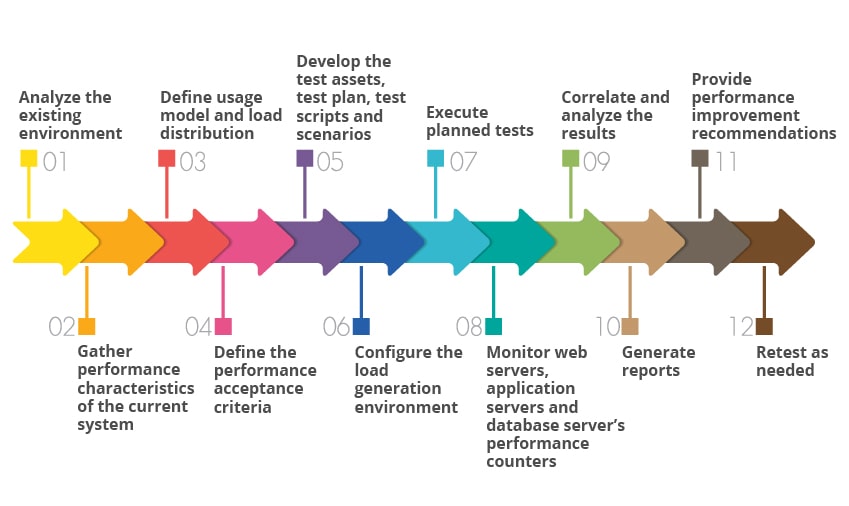Published: 08 Jul 2020
Major Performance Testing Challenges and How to Overcome Them
Last Updated: 23 Nov 2023
Software testing plays a major role along with software development in the software development lifecycle (SDLC). This testing process involves the testing of the software developed to ensure it is as per the requirements defined and error free for end users. Software testing can be categorized into two major types as Functional testing and Non-functional testing types.
Content
1. What is Performance Testing
2. Why is Performance Testing Essential for Testing Business Websites and Mobile Apps?
2.1 Performance Testing Process in Software Testing
3. What are the Challenges of Performance Testing and How to Overcome Them?
3.1 Selection of wrong performance testing tools
3.2 Lack of proper test strategy & test coverage
3.3 Time and budget constraints
3.4 Lack of knowledge about need for performance tests
3.5 Improper analysis of performance test outcomes
3.6 Difficulty in conducting tests on production environment
4. Conclusion
Some of the common types of functional testing are Unit, Integration, System, Sanity, Smoke, Interface, Regression, Acceptance testing, etc. Some of the most common Non-functional testing types are Reliability, Endurance, Localization, Recovery and Performance testing to name a few.
Out of these testing types, Performance testing is one of the important testing process that plays a critical role by ensuring the software performs stably and seamlessly even under varying load conditions.
What is Performance Testing?

Performance or load testing is an important non-functional type of testing and involves the process by which software or an application is tested to know its current system performance.
This sort of testing checks how your current system performs in terms of responsiveness and stability when tested under varying workload conditions. Significantly, the system is tested under multiple and different load and network conditions and this testing process effectively checks the time taken by the system to respond under these different loads.
Performance testing also ensures that the application performs as expected irrespective of the network fluctuations, bandwidth availability, or the load of traffic. Basically, this testing process determines the speed with which the system works and some of the issues identified with this type of testing are runtime bloat, optimization issues related to speed, latency, throughput, poor response times, load balancing problems, and other bandwidth issues if any.
There are various types of performance testing that are commonly adopted which include Endurance testing, Load testing, Volume testing, Stress testing, Scalability testing, Spike testing, etc. and these testing methods determines the speed, and responsiveness of the website, the app or the network when tested under different workloads.
Why is Performance Testing Essential for Testing Business Websites and Mobile Apps?

Performance testing measures the speed, scalability, reliability, and stability of the software under varying loads thus ensuring their stable performance. Every business application has to be stable and deliver consistent results, irrespective of the number of users accessing it at any point of time. Especially, with respect to banking apps, eCommerce apps, etc. these apps need to perform seamlessly even with numerous users, else it adversely affects the brand reputation.
Today’s users prefer apps that load spontaneously and get enticed with these apps that perform seamlessly and deliver great user experience. If the apps deliver slow response while accessing them, users tend to leave such apps and look out for alternatives.
Evidently, today it is essential for businesses to ensure the performance of their business apps and websites is seamless in order to deliver great customer experience. Performance tests such as load and stress tests determine the behaviour of the application, and help to check whether the server responds to the user with requested data within the stipulated time.
Hence, it is essential for business websites and mobile apps to work effectively even under heavy load of users, as it is important for them to keep going to ensure business continuity. Therefore, Performance testing is critical for business success and should be leveraged by enterprises.
Performance Testing Process in Software Testing
Now, let us try to list different activities of the Performance testing to get an understanding of the actual Performance testing process listed below:

– Analyze the existing environment
– Gather performance characteristics of the current system
– Define usage model and load distribution
– Define the performance acceptance criteria
– Develop the test assets, test plan, test scripts and scenarios
– Configure the load generation environment
– Execute planned tests
– Monitor web servers, application servers and database server’s performance counters
– Correlate and analyze the results
– Generate reports
– Provide performance improvement recommendations
– Retest as needed
Specifically, it is the QA team that is involved in the process of performance testing. The team needs to follow all the steps in order to perform this testing process to deliver effective results.
But, typically, while performing this method of performance testing or load testing, there are certain challenges which should be handled by the teams to ensure the success of the performance testing process.
What are the Challenges of Performance Testing and How to Overcome Them?

1. Selection of wrong performance testing tools:

This is a common challenge and in many situations the most appropriate performance testing tool is not selected. This tool selection depends on a number of factors such as application communication protocol, application technology stack, skill-level of the performance tester and the licencing cost of the tool.
If a wrong tool is chosen, then it might lead to loss of testing days for getting the test scripts to work and it is necessary that the chosen performance tool should recognize the controls of the application under test.
Solution:
It is necessary for the QA manager and the QA team to properly evaluate the application under test (AUT) along with licencing cost involved, and then choose the best performance testing tool to ensure success of the testing process.
2. Lack of proper test strategy & test coverage:

There is a lot of effort involved in designing a comprehensive testing strategy which takes care of identifying and prioritizing project risks and deciding on what actions to be taken to mitigate them.
This testing process involves identifying application performance characteristics, planning appropriate tests to exercise those characteristics, simulating real user interactions, testing of API services and testing whether all these services are working or not as part of the test strategy. Due to the lack of proper brainstorming while creation of test strategy and test coverage, it becomes difficult to get effective performance test results.
Solution:
The performance team should spend significant effort on analysing and understanding application architecture and other performance characteristics like load distribution, usage model, geography of usage, availability requirements, resilience requirements, reliability requirements, technology stack etc.
A proper and clear testing strategy should be developed to ensure validation of these performance characteristics to get effective performance test results.
3. Time and budget constraints:

Load testing essentially takes some time and budget to get effective results. Due to the lack of proper planning during software development, allocation of resources or budget is not done. This leads to dependence on low-skilled resources, who do not understand full scope of performance testing activities.
It also might lead to usage of open source tools which might lead to increased project risk. All these factors impact the quality of overall performance testing process.
Solution:
Therefore, at the beginning of projects, it is essential for businesses to plan for proper performance testing activities accounting for required timeframe, resources and proper budget allocations.
4. Lack of knowledge about need for performance tests:

Most stakeholders and budget makers do not recognize the value of performance testing during software development. In most instances, post production release of software, many performance issues may crop up which might result in crashing of the website, app or software.
Solution:
Evidently, it is essential for the stakeholders, product owners or test architect to plan for performance testing as part of end-to-end testing strategy. These applications should be performance tested exercising web servers, databases and third party apps to ensure effective performance.
5. Improper analysis of performance test outcomes:

This is indeed a significant challenge faced by many testers as a good amount of system and application knowledge is essential to deeply analyze the performance test results.
Solution:
An experienced performance tester should perform the testing process who will be able to judge the scenarios and could continuously refine the tests and keep adding tests to make them consistent. The performance tester should be well aware of application architecture.
Also, the performance tester should have experience across OS concepts, web architecture, OSI model, networking concepts, data structures, client-side performance concepts and server-side performance concepts. These performance experts will be able to quickly analyze the test results.
6. Difficulty in conducting tests on production environment:

Conducting load tests on a fully functioning production environment is a challenge. Especially while testing in such situations, real-time users are using the product and any change to the production environment might affect the user experience.
Solution:
It is essential to closely monitor the trends in the production environment in order to spot out irregularities. The performance testing activities should ideally be planned in production like environment instead of actual production environment.
If business needs demand execution in actual production environment, such activities should be executed only during off business hours with sufficient time in hand for any corrective actions in case application crashes under load in production.
Earlier, load testing was mostly taken up to simulate basic user actions at a protocol level. But, today with more complex applications in place with intricate user actions, load testers might need to balance between automation and exploratory testing to handle these new technology complex applications.
Conclusion:
Performance testing is a non-functional type of testing that is performed to ascertain how the system performs under varying load conditions. The speed, scalability, reliability and resource usage of the software or the application is evaluated with this type of testing. It is essential for business websites especially eCommerce sites and mobile apps to get performance tested to ensure they scale up when numerous users access simultaneously.
There are many types of performance testing methods that can be adopted to test the software. But, typically while performing this testing method, the QA teams tend to encounter certain challenges. Specifically, the QA teams need to follow certain measures to overcome these above listed challenges to deliver stable and quality software.
Last but not the least, it is essential for businesses to leverage performance testing services provider to be assured of scalable, stable and high-performing software.
Talk to our experts today to discuss your unique QA challenges and see how we bring value to your business
Related Queries on Performance Testing
Q1. What is Performance Testing
Ans. Performance or load testing is an important non-functional type of testing and involves the process by which software or an application is tested to know its current system performance.
Q2. What are the types of performance testing?
Ans. There are various types of Application and software performance testing.
Click here to read more.
Q3. What are the tools of performance testing?
Ans. There are certain performance testing tools that can be used to deliver effective performance to e-commerce, mobile apps, and other systems. Read
full list of tools here.